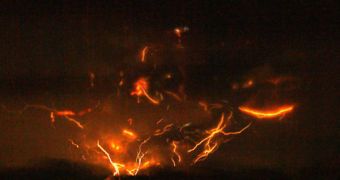Ever since Alaska's Mount Redoubt volcano showed the first signs that it might erupt again, geologists have installed cameras in areas around it, in hopes of catching the phenomena associated with its eruption in more detail. One of the cameras has caught a spectacular image, of a lighting zipping through the giant ash plume that was generated at the top of the mountain. The Lightning Mapping Array is a system that is capable of peering through the gas and dust inside the plumes, at the very core of the ashes, and resolve events going on inside.
For the outside observer, the lightings that occur inside volcano plumes appear as if the ash clouds are being lit from the inside out, but it's very seldom that the actual lighting is visible. This happens because the electricity generated by the atmospheric event is triggered by the phenomena that the ash itself produces in the clouds. Therefore, the lighting usually strikes at the core of its source, namely in the middle of the active crater, LiveScience reports.
“The lightning activity was as strong or stronger than we have seen in large Midwestern thunderstorms. The radio frequency noise was so strong and continuous that people living in the area would not have been able to watch broadcast VHF television stations,” New Mexico Tech physicist Paul Krehbiel said. He added that the lightings produced when the March 22nd eruption occurred were “prolific” and that some of them were actually very intense.
“For the first time, we had the Lightning Mapping Array on site before the initial eruption,” New Mexico Tech scientist Sonja Behnke explained. “The data will allow us to better understand the electrical charge structure inside a volcanic plume. That should help us learn how the plume is becoming electrified, and how it evolves over time,” another of the company's experts, Ron Thomas, pinpointed. Experts at the Alaska Volcano Observatory (AVO), which closely monitored the Redoubt situation, told that the eruptions would continue, to some extent, for weeks, or even months.
The mountain started showing signs of activity in January, but only erupted for the first time on March 22nd. After about three days in which more than ten minor eruptions were recorded, the activity dropped for a few days, until Redoubt started spilling ash again, on March 28th. During these days, the LMA collected a large amount of data about how ash plumes resembled tornadoes shortly after exiting the crater.

 14 DAY TRIAL //
14 DAY TRIAL //